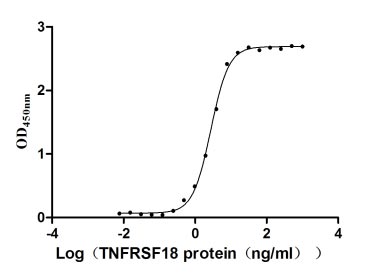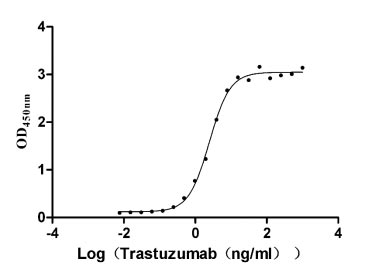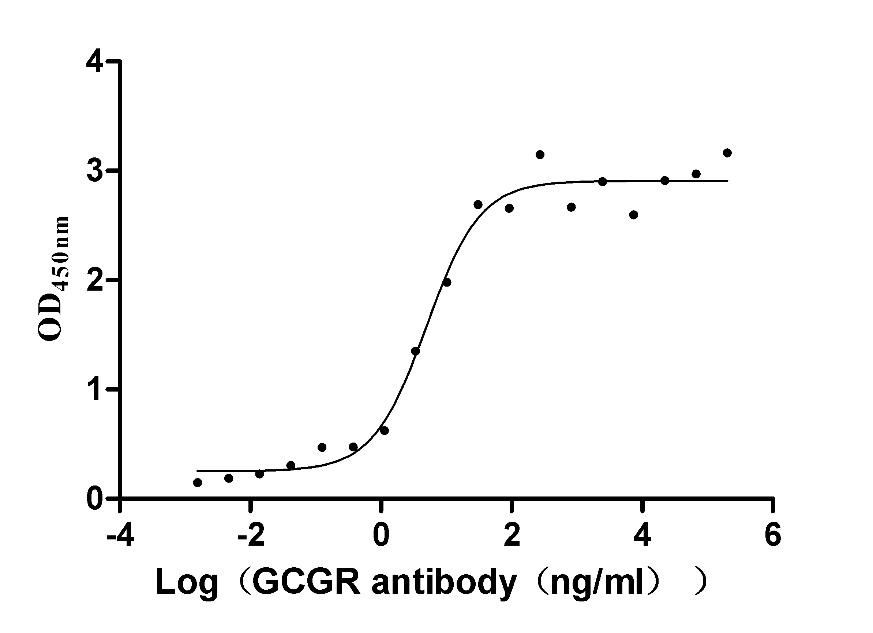Recombinant Human Artemin (ARTN)
-
货号:CSB-YP002160HU
-
规格:
-
来源:Yeast
-
其他:
-
货号:CSB-EP002160HU-B
-
规格:
-
来源:E.coli
-
共轭:Avi-tag Biotinylated
E. coli biotin ligase (BirA) is highly specific in covalently attaching biotin to the 15 amino acid AviTag peptide. This recombinant protein was biotinylated in vivo by AviTag-BirA technology, which method is BriA catalyzes amide linkage between the biotin and the specific lysine of the AviTag.
-
其他:
-
货号:CSB-BP002160HU
-
规格:
-
来源:Baculovirus
-
其他:
-
货号:CSB-MP002160HU
-
规格:
-
来源:Mammalian cell
-
其他:
产品详情
-
纯度:>85% (SDS-PAGE)
-
基因名:ARTN
-
Uniprot No.:
-
别名:Artemin; Artn; ARTN_HUMAN; Enovin; EVN; NBN; Neublastin; Neurotrophic factor
-
种属:Homo sapiens (Human)
-
蛋白长度:Full Length of Mature Protein
-
表达区域:108-220
-
氨基酸序列AGG PGSRARAAGA RGCRLRSQLV PVRALGLGHR SDELVRFRFC SGSCRRARSP HDLSLASLLG AGALRPPPGS RPVSQPCCRP TRYEAVSFMD VNSTWRTVDR LSATACGCLG
-
蛋白标签:Tag type will be determined during the manufacturing process.
The tag type will be determined during production process. If you have specified tag type, please tell us and we will develop the specified tag preferentially. -
产品提供形式:Lyophilized powder
Note: We will preferentially ship the format that we have in stock, however, if you have any special requirement for the format, please remark your requirement when placing the order, we will prepare according to your demand. -
复溶:We recommend that this vial be briefly centrifuged prior to opening to bring the contents to the bottom. Please reconstitute protein in deionized sterile water to a concentration of 0.1-1.0 mg/mL.We recommend to add 5-50% of glycerol (final concentration) and aliquot for long-term storage at -20℃/-80℃. Our default final concentration of glycerol is 50%. Customers could use it as reference.
-
储存条件:Store at -20°C/-80°C upon receipt, aliquoting is necessary for mutiple use. Avoid repeated freeze-thaw cycles.
-
保质期:The shelf life is related to many factors, storage state, buffer ingredients, storage temperature and the stability of the protein itself.
Generally, the shelf life of liquid form is 6 months at -20°C/-80°C. The shelf life of lyophilized form is 12 months at -20°C/-80°C. -
货期:Delivery time may differ from different purchasing way or location, please kindly consult your local distributors for specific delivery time.Note: All of our proteins are default shipped with normal blue ice packs, if you request to ship with dry ice, please communicate with us in advance and extra fees will be charged.
-
注意事项:Repeated freezing and thawing is not recommended. Store working aliquots at 4°C for up to one week.
-
Datasheet :Please contact us to get it.
相关产品
靶点详情
-
功能:Ligand for the GFR-alpha-3-RET receptor complex but can also activate the GFR-alpha-1-RET receptor complex. Supports the survival of sensory and sympathetic peripheral neurons in culture and also supports the survival of dopaminergic neurons of the ventral mid-brain. Strong attractant of gut hematopoietic cells thus promoting the formation Peyer's patch-like structures, a major component of the gut-associated lymphoid tissue.
-
基因功能参考文献:
- Artemin could promote the proliferation and invasiveness of lung cancer cells in vitro and therefore could be a new potential target to combat lung cancer. PMID: 29575549
- The data suggest that ARTN and MMP-9 are involved in the occurrence, development, invasion and metastasis of EC, and play a synergistic role in the development of EC and lymphatic metastasis. PMID: 29254290
- AhR activation and ARTN expression were positively correlated in the epidermis of patients with atopic dermatitis. PMID: 27869817
- Report the activity, pharmacokinetics, conformational dynamics and biophysical properties of different glycoforms of ART. PMID: 26908049
- High ARTN increased xenograft tumor size and metastasis in hepatocellular carcinoma. PMID: 26675549
- Artemin expression promotes invasiveness and neurotrophic function of pancreatic adenocarcinoma cells in vivo and in vitro PMID: 25243385
- mRNA expression of Artemin (Artn) in the tongue mucosa of patients with burning mouth syndrome was significantly higher than that of control subjects. PMID: 26270588
- This is the first report of increased levels of a neurotrophic factor and of a glial cell line-derived neurotrophic factor family member in GAD patients. PMID: 24994477
- conclude that ARTN is one mediator of acquired resistance to trastuzumab in HER2-positive mammary carcinoma cells PMID: 24737320
- The expression of GFRalpha1 and/or GFRalpha3, especially when combined with ARTN expression, may be useful predictors of disease progression and outcome in specific subtypes of mammary carcinoma. PMID: 23351331
- ARTEMIN promotes de novo angiogenesis in ER negative mammary carcinoma through activation of TWIST1-VEGF-A signaling. PMID: 23185544
- ARTN promotion of the cancer stem cell-like cell phenotype was mediated by TWIST1 regulation of BCL-2 expression. PMID: 23095743
- High artemin promotes motility and invasiveness of pancreatic cancer. PMID: 22901124
- artemin lowers the threshold of temperature-dependent itch sensation. PMID: 22770266
- ARTN and TWIST1 synergize to produce a worse outcome in ER-MC and combined inhibition of ARTN and phosphatidylinositol 3-kinase/protein kinase B (PI3K/AKT) may therefore provide a novel therapeutic strategy in this subtype of mammary carcinoma. PMID: 22060274
- Presenting an efficient method for the recombinant bacterial production of large quantities of highly pure, biologically active ARTN for in vitro and in vivo studies. PMID: 21907286
- Studies indicate that artemin was highly expressed in squamous cell carcinoma lung cancer. PMID: 22008109
- These results reveal that ARTN, a known tumor metastasis-related gene, is a direct target of miR-223. PMID: 21453483
- Forced expression of ARTN in ER-positive human mammary carcinoma cells increased ER transcriptional activity, promoted estrogen-independent growth and produced resistance to tamoxifen. PMID: 20305694
- ARTN increased BCL2 expression by transcriptional upregulation, and inhibition of BCL2 abrogated the oncogenic properties of ARTN in non-small cell lung carcinoma cells. PMID: 20530713
- Artemin is a key player in the generation of pancreatic neuropathy in pancreatic neoplasms. PMID: 20395845
- Artemin and GFRalpha3 expressions may play an important role in perineural invasion of pancreatic carcinoma. PMID: 19304517
- expression in endometrial carcinoma significantly associated with higher tumor grade and invasiveness PMID: 20118197
- The results obtained suggest the involvement of NTN, PSP, and ART in processes subserving both the organization of this cortical region during development and the functional activity and maintenance of the mature human hippocampal neurons. PMID: 15829225
- This study suggests that ART binds heparan sulfate proteoglycans (HSPG) and identifies residues that may be involved in HSPG binding. PMID: 16734417
- 1.92 A crystal structure of the complex formed between ARTN and its receptor GFRalpha3 was reported. PMID: 16765900
- Data show that reduced expression levels of ARTN mRNAs are found in patients with major depressive disorder in a current depressive state, but not in a remissive state. PMID: 18313696
- No differences were found in the allelic frequencies of the variants or in the haplotype distribution between Hirschsprung's disease patients & controls, nor to any demographic/clinical parameters within the group of patients. PMID: 18970938
- Forced expression of artemin in mammary carcinoma cells results in increased anchorage-independent growth, increased colony formation in soft agar and in Matrigel, and promotes a scattered cell phenotype with enhanced migration and invasion. PMID: 19363524
显示更多
收起更多
-
亚细胞定位:Secreted.
-
蛋白家族:TGF-beta family, GDNF subfamily
-
组织特异性:Ubiquitous. Expressed at high levels in peripheral tissues including prostate, placenta, pancreas, heart, kidney, pituitary gland, lung and testis. Expressed at low levels in the brain.
-
数据库链接:
HGNC: 727
OMIM: 603886
KEGG: hsa:9048
STRING: 9606.ENSP00000387435
UniGene: Hs.632404
Most popular with customers
-
Recombinant Human Tumor necrosis factor receptor superfamily member 18 (TNFRSF18), partial (Active)
Express system: Mammalian cell
Species: Homo sapiens (Human)
-
Recombinant Human Receptor tyrosine-protein kinase erbB-2 (ERBB2), partial (Active)
Express system: Mammalian cell
Species: Homo sapiens (Human)
-
Recombinant Human Glucagon receptor (GCGR), partial (Active)
Express system: Mammalian cell
Species: Homo sapiens (Human)
-
Recombinant Human Claudin-4 (CLDN4)-VLPs (Active)
Express system: Mammalian cell
Species: Homo sapiens (Human)
-
Recombinant Human Trophoblast glycoprotein (TPBG), partial (Active)
Express system: Mammalian cell
Species: Homo sapiens (Human)
-
Recombinant Human Cell adhesion molecule 1 (CADM1), partial (Active)
Express system: Mammalian cell
Species: Homo sapiens (Human)
-
Recombinant Macaca Gastric inhibitory polypeptide receptor(GIPR), partial (Active)
Express system: yeast
Species: Macaca fascicularis (Crab-eating macaque) (Cynomolgus monkey)
-
Recombinant Human Kidney-associated antigen 1(KAAG1) (Active)
Express system: Baculovirus
Species: Homo sapiens (Human)




















